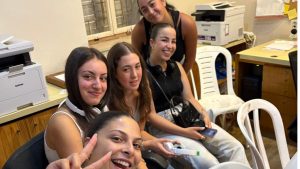We were the Zelaznys from Kalushyn
Zelazny Sisters at family reunion circa 1953 and their children with their spouses, Bridgeport, Conn. Their brother Avram Tsal died at Treblinka in 1942.
Published November 2, 2022
I grew up in Bridgeport and Fairfield, Conn. surrounded by father’s family — the Levines. My grandmother Anna and my grandfather Isaac Levine lived across the street from my elementary school, and right next to the candy store. I saw them nearly every day, and we spent most weekends with some combination of aunts, uncles, cousins, second cousins, and relatives of my grandmother’s three sisters.
We were then, and still are, remarkably close. Though now, several cousins and I are the only ones left who know some of the history and the fun of growing up in that noisy band of “mishpocheh.”
My grandmother and her sisters were the matriarchs of the family, the Zelazny sisters. They had all emigrated from Kalushyn, Poland between about 1900 and 1910. I knew that they had a brother Avram Tsal, who once came to the United States, but returned to Poland to remain in the family business of scrap iron. I think today we would call that a recycling business. That’s all I knew about him, a name and the position as one who remained in Kalushyn.
What I did not know until I was grown, and raising my own family, was that Avram Tsal, his wife Shaindel, and their daughters Richel and Gittel died in Treblinka in 1942. Their son Zelig had enlisted in the Polish Army in 1939, and then joined the Russian Army. Zelig’s first wife was killed in the Holocaust, but I know nothing else. After the war Zelig’s second wife and their family emigrated to Israel in 1948. Why didn’t my Grandmother Anna tell me these stories? She certainly told me many other stories and made me, no doubt, the woman I have become.
Every year our family gathered twice a year with all the cousins, in-laws and outlaws. Summertime was a picnic in a park and winter was in a hotel in Connecticut or New York City. While the kids ran wild and played in the woods or the river, our aunts and mothers talked for hours while our uncles and fathers pitched horseshoes and grilled the hotdogs and hamburgers from Great Uncle Herman’s slaughterhouse. Then it was time for the “family circle” business meeting. They even took minutes for several years and they started a collection to help Zelig buy a truck and start his business in Israel.
As the historian and museum person in the family, I was given many of the documents and photographs of our family. The one I treasure the most is Grandma Anna’s Naturalization application signed by her in May 1941. My grandmother became a citizen after 35 years of
living in New York, Pennsylvania and Connecticut with my grandfather and their seven surviving children operating bakeries to support the family and their communities. She became a citizen during World War II while one of her sons was serving in the United States Air Force, another son served in the U.S. Navy, and a son-in-law was fighting with the U.S. Army in Europe.
We — myself and my 12 cousins — heard so much about what my grandmother and our mothers did to support the war efforts, but she didn’t often talk about why she left Poland in 1907, why Avram Tsal returned there, or what she knew about her family in Poland during the war. And she never, ever told us about the death of Avram Tsal and his family. Anything I have learned about the pogroms in Kalushyn, the Nazi occupation in 1939, and the round up and deportment of Jews from there to Treblinka in September 1942, I learned from the United States Holocaust Memorial Museum, or from reading and research of my own.
Several times I asked my grandmother to take me back to Poland so that I could see Kalushyn, the town where she was raised. She always said to me, “I did not leave anything there.” But now, as an adult and a historian, I understand that she left everything there, her mother and father, her brother, and her community, her childhood memories, and the earliest memories of her happy marriage to my grandfather. She started all over here in the United States, and those were the memories she was building. She protected me and nurtured me. And just maybe she herself could not yet confront those truths of what she left behind.
This year, maybe better than ever, I understand what her choices were, even if she did not say them in words. The photos of war that we now see daily from Ukraine have made us all keenly aware of the power and the dread of displacement. This year, too, I understand more about the resilience that brought so many Holocaust refugees to embrace a new life in the United States. And this year, I join with the staff of the St. Louis Kaplan Feldman Holocaust Museum so that all our children and their children, your grandchildren and great grandchildren will learn your stories and learn from the history of this museum.














